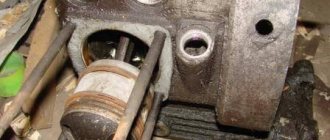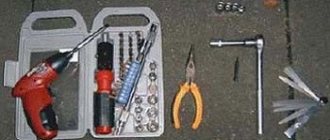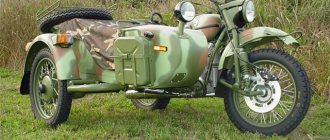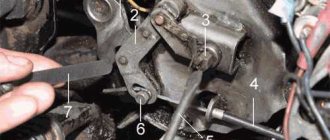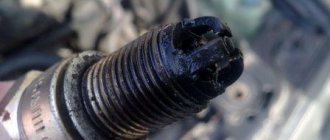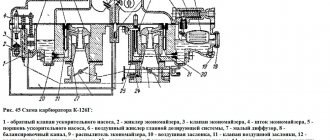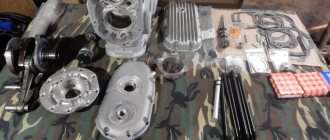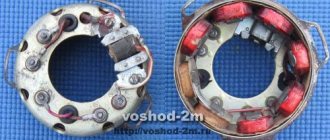What is thermal gap
The term thermal clearance refers to the distance between the rocker arm and the upper end of the valve.
This allows for the inevitable thermal expansion of engine parts to ensure optimal operation of the valve mechanism. The disadvantage of having such a gap is the low stability of the engine when starting when cold, but it works great when fully warmed up. It should be remembered that the gap must be appropriate for the engine model. On older models, the alloys are less stable, so it is recommended to set this indicator to 0.1 mm. On more modern engines, the gap can be set within 0.05 mm.
Why adjustment is needed
To understand why valves are adjusted in the Urals, let’s look at how the engine works with different adjustable clearances:
- With a small gap, especially if the pusher fits closely, low compression is observed. Even on a hot engine there is a gap. In this case, the engine operates unstably at any temperature; on a hot engine, characteristic knocking noises will be heard, and popping noises may occur in the carburetor;
- If there is a large gap on the valves, they do not open completely. At the same time, the combustion chamber is poorly ventilated and is also not sufficiently filled with the fuel-air mixture. This leads to unstable operation of the motor.
If there are strong deviations in the clearances, the engine operates very unstable, to the point of being unable to start. Adjustments are made to avoid these problems.
Valve lapping
During the operation of the motorcycle, the need to replace the valve may arise.
Before replacing any valve in the cylinder heads, it must be ground in so that it fits as tightly as possible to the seat. The further operation of the engine depends on this work. If you do not ground in the valve, over time the head will simply burn out. We begin to grind the valve step by step, observing the following steps: We put the spring on the valve. The size of the spring should be such that it lifts the valve head from the seat by 3-6 mm. We apply a not very thick layer of grinding paste to the chamfer of the valve head (if there is none, you can use rubbed red brick mixed with oil into the dust), insert the valve with the spring in the guide sleeve, put any device for rotation on the end of the rod, be it a brace, drill or other. We begin rotation. Rotate the valve in both directions so that it has a translational rotation in one direction, and periodically lightly press it against the seat. Lather the head to the seat carefully, without removing a lot of metal from the working chamfers, so that during subsequent valve replacements they can be ground in again. Towards the end of lapping, reduce the amount of paste, adding clean oil and finish lapping with clean oil. When the working surface of the parts being ground becomes a uniform matte gray color (without black spots), finish lapping. After lapping, rinse the valves, their seats, guide bushings, neck and combustion chamber of the cylinder head and wipe so that everything is clean and dry. Then check the tightness of the valves. To do this, put them in place in the heads and, pressing the valve heads to the seat, pour kerosene into all channels of the cylinder head one by one. It is acceptable for kerosene to leak, but not earlier than after a minute. If kerosene leaks earlier, you must repeat lapping. This is a very delicate job, so we take our time and grind it carefully. Carbon deposits from the cylinder heads and pistons are removed with a wooden scraper. It must be moistened with kerosene to soften and prevent the formation of lead dust.
Required Tools
Before you start adjusting the valves, you should prepare the necessary tools. First of all, you will need a set of keys. In practice, you will only need one, but it is better to have everything on hand.
The motorcycle valves are directly adjusted using feeler gauges. Depending on the motor model, different probes may be needed. On the M 72 Ural, a thickness of 0.1 mm will be required; for newer engines, for example, IMZ, it is better to use 0.05 mm.
In fact, these are very conditional indicators. There is a small tolerance during adjustment, but under operating conditions of the power unit this does not affect its performance.
You will need to stock up on a small container to catch the oil; it can sometimes spill. Also, a rag will not be superfluous; it can be used to clean the engine from dirt. Let's see how to properly perform this repair.
Messages [1 to 20 of 33]
- MORDBIN[13Rus]
- Participant
- Inactive
- Name: Andrey
- From: Krasnoslobodsk
- Registered: 14-09-2013
- Posts: 35
- Motorcycle: Dnepr-11
Topic: Grinding in valves on the Dnieper
Good evening everyone! Please tell me how to properly grind the valves and what to use?
- MORDBIN[13Rus]
- Participant
- Inactive
- Name: Andrey
- From: Krasnoslobodsk
- Registered: 14-09-2013
- Posts: 35
- Motorcycle: Dnepr-11
Re: Grinding in valves on the Dnieper
Nurik writes:
I would bore the valve hole and press the rings there like on a car
I just need to grind them in and that’s all)
- PATRIOT
- Patriot IMZ
- Inactive
- Name: Ilya
- From: Krasnodar region, Krasnodar
- Registered: 02/18/2011
- Posts: 3,148
- Reputation: 180
- Motorcycle: No. Next will be the K750!
Re: Grinding in valves on the Dnieper
For lapping you need lapping paste and a piece of gas hose.
It depends on the condition of your valves. Maybe they need to be changed! But if the sinks are small, you can get by with lapping! You remove the head and valves. You wash everything with gasoline until it’s so clean that you can lick it with your tongue. Then apply a little rubbing paste on the valve seat in a circle, put the valve on the bottom, put the hose on the valve, and rotate your hands left and right and pull the valve down a little. But gradually you must rotate to the right. and periodically lift the valve from the seat and lower it again so that the path is uniform. And so it will take you about 30 minutes for each head. I polished all the valves in my Ural in one evening. there is nothing difficult at all. The main thing is to rotate your hands more intensely. you'll pump up your hands a little
and about the pasta... You can take the regular one in one tube, or you can take (as I did) for roughing and for finishing grinding in one box.
In the Urals with direct flow, I like to give it a good gas, so that passers-by’s shoelaces come undone, and leaves fall from the trees….
- MORDBIN[13Rus]
- Participant
- Inactive
- Name: Andrey
- From: Krasnoslobodsk
- Registered: 14-09-2013
- Posts: 35
- Motorcycle: Dnepr-11
Re: Grinding in valves on the Dnieper
PATRIOT writes:
For lapping you need lapping paste and a piece of gas hose.
It depends on the condition of your valves. Maybe they need to be changed! But if the sinks are small, you can get by with lapping! You remove the head and valves. You wash everything with gasoline until it’s so clean that you can lick it with your tongue. Then apply a little rubbing paste on the valve seat in a circle, put the valve on the bottom, put the hose on the valve, and rotate your hands left and right and pull the valve down a little. But gradually you must rotate to the right. and periodically lift the valve from the seat and lower it again so that the path is uniform. And so it will take you about 30 minutes for each head. I polished all the valves in my Ural in one evening. there is nothing difficult at all. The main thing is to rotate your hands more intensely. you'll pump up your hands a little
and about the pasta... You can take the regular one in one tube, or you can take (as I did) for roughing and for finishing grinding in one box.
yeah) what pasta is better to buy?
Added: 09/23/2013 19:51:40
Nurik writes:
pass the togo, drill and forward
how to use a drill in more detail)
- harp
- Assistant
- Inactive
- Registered: 01-08-2013
- Posts: 297
- Reputation: 30
- Motorcycle: IMZ-8.103-10
Re: Grinding in valves on the Dnieper
I also put a weak spring under the valve to move it a little away from the seat. And at the very beginning I ground it with a screwdriver, occasionally pressing the valve to the seat through the gas hose and changing the direction of rotation. But this is a tedious task, either manually or with devices.
- mexanik62
- Mechanic from the 30s.
- Inactive
- Name: Uncle Vitya
- From: Evpatoria
- Registered: 03-08-2011
- Posts: 10,832
- Reputation: 1,151
- Motorcycle: 12-volt K-750, ZAZ Sens Hatchback
Re: Grinding in valves on the Dnieper
Lapping paste must be made from abrasive under a sharpening machine, mixing it with motor grinding. I’ll tell you a secret, it’s not clear who and why moves lapping pastes and escho of different grain sizes? and where does the need for mirror polishing of chamfers come from? After 10-15 minutes of running the engine, the chamfers will be polished!
...nothing can stop this Soviet motorcycle, not even its own brakes...
- PATRIOT
- Patriot IMZ
- Inactive
- Name: Ilya
- From: Krasnodar region, Krasnodar
- Registered: 02/18/2011
- Posts: 3,148
- Reputation: 180
- Motorcycle: No. Next will be the K750!
Re: Grinding in valves on the Dnieper
meksanik62 writes:
Lapping paste must be made from abrasive under a sharpening machine, mixing it with motor grinding. I’ll tell you a secret, it’s not clear who and why moves lapping pastes and escho of different grain sizes? and where does the need for mirror polishing of chamfers come from? After 10-15 minutes of running the engine, the chamfers will be polished!
With properly adjusted clearances...
In the Urals with direct flow, I like to give it a good gas, so that passers-by’s shoelaces come undone, and leaves fall from the trees….
- shaman507
- Angry moderator
- Inactive
- Name: Evgeniy
- From: Tambov region
- Registered: 05/28/2013
- Posts: 4,387
- Reputation: 423
- Motorcycle: Dnepr MT 10-36, M-72, Ural IMZ-8.103-10, M-63, IZH-49, Militia Ural single, Minsk M-106
Re: Grinding in valves on the Dnieper
PATRIOT writes:
With properly adjusted clearances...
To break in, I set larger gaps, drive around a little, stretch the head and cylinder if I remove it. I’ll go again, pull it out again and finally set the gaps.
Edited by shaman507 (09/24/2013 08:49:21)
- on drakone
- Elder
- Inactive
- Name: Albert
- From: Omsk region. Omsk city
- Registered: 07-12-2012
- Posts: 4,972
- Reputation: 125
- Motorcycle: Ural 8.103.10, GAZ 31029
Re: Grinding in valves on the Dnieper
how to use a drill in more detail)
you attach some kind of rubber band to the drill (like I use a vase from the jet thrust), you push the bolt through, preferably with a nut so that it’s tight, well, because of the larger size of the bolt and nut and the butt end of the bolt, you clamp it in the drill and while lubricating it with paste and with subsequent pressure and forceful rotation, everything will be trampled as it should, until there’s a nice whistle, and then it’s the look. but I would buy valves right away if the head is old
- PATRIOT
- Patriot IMZ
- Inactive
- Name: Ilya
- From: Krasnodar region, Krasnodar
- Registered: 02/18/2011
- Posts: 3,148
- Reputation: 180
- Motorcycle: No. Next will be the K750!
Re: Grinding in valves on the Dnieper
Never grind with a drill! this is complete bullshit... High-quality grinding only by hand.
In the Urals with direct flow, I like to give it a good gas, so that passers-by’s shoelaces come undone, and leaves fall from the trees….
- MORDBIN[13Rus]
- Participant
- Inactive
- Name: Andrey
- From: Krasnoslobodsk
- Registered: 14-09-2013
- Posts: 35
- Motorcycle: Dnepr-11
Re: Grinding in valves on the Dnieper
on drakone writes:
how to use a drill in more detail)
you attach some kind of rubber band to the drill (like I use a vase from the jet thrust), you push the bolt through, preferably with a nut so that it’s tight, well, because of the larger size of the bolt and nut and the butt end of the bolt, you clamp it in the drill and while lubricating it with paste and with subsequent pressure and forceful rotation, everything will be trampled as it should, until there’s a nice whistle, and then it’s the look. but I would buy valves right away if the head is old
no one has ever touched the heads since its existence, that is, since 1989, but they worked fine)) I have 2 engines, if so, I’ll see what can be replaced) by the way, how much does a set of valves for the Dnieper cost?
Added: 09/24/2013 16:23:04
PATRIOT writes:
Never grind with a drill! this is complete bullshit... High-quality grinding only by hand.
can I have a video?? I just can’t figure out how to do it manually and what to do with the hose(?
- PATRIOT
- Patriot IMZ
- Inactive
- Name: Ilya
- From: Krasnodar region, Krasnodar
- Registered: 02/18/2011
- Posts: 3,148
- Reputation: 180
- Motorcycle: No. Next will be the K750!
Re: Grinding in valves on the Dnieper
One valve will cost 100 rubles. So consider...
In the Urals with direct flow, I like to give it a good gas, so that passers-by’s shoelaces come undone, and leaves fall from the trees….
- Voldemar
- Assistant
- Inactive
- Name: Vladimir
- From: Severonezhsk Arkhangelskaya region.
- Registered: 01/26/2013
- Posts: 177
- Reputation: 31
- Motorcycle: Dnepr 11 single, 11 with sidecar.
Re: Grinding in valves on the Dnieper
My complete repair kit for the heads came out to ~1300 (there were: seats, guides, valves, springs, crackers). As for grinding in with a drill, as stated above, it’s complete nonsense, you won’t grind it in properly, buy a device for the valves. If you are thinking of changing the valves, look at the condition of the seats, maybe they will need to be ripped apart for new valves.
...this is not this for you...
- MORDBIN[13Rus]
- Participant
- Inactive
- Name: Andrey
- From: Krasnoslobodsk
- Registered: 14-09-2013
- Posts: 35
- Motorcycle: Dnepr-11
Re: Grinding in valves on the Dnieper
Voldemar writes:
My complete repair kit for the heads came out to ~1300 (there were: seats, guides, valves, springs, crackers). As for grinding in with a drill, as stated above, it’s complete nonsense, you won’t grind it in properly, buy a device for the valves. If you are thinking of changing the valves, look at the condition of the seats, maybe they will need to be ripped apart for new valves.
I’m sorry, but I don’t understand the devil, I got the motorcycle from my grandfather) and my dad doesn’t want to help at all, he says your motorcycle is whatever you want, do it, no one helped me at all ((I rode for 2 years) if I send you photos or a video, you can advise me what to do how to make it better?) I just really liked the motorcycle and would like to fix it)))
- Voldemar
- Assistant
- Inactive
- Name: Vladimir
- From: Severonezhsk Arkhangelskaya region.
- Registered: 01/26/2013
- Posts: 177
- Reputation: 31
- Motorcycle: Dnepr 11 single, 11 with sidecar.
Re: Grinding in valves on the Dnieper
Well, of course, we all help each other here, don’t touch the saddles without the proper experience and skill, if you doubt anything, buy a repair kit and give it to a motorist with your hands, it’s 2 hours of work.
...this is not this for you...
- MORDBIN[13Rus]
- Participant
- Inactive
- Name: Andrey
- From: Krasnoslobodsk
- Registered: 14-09-2013
- Posts: 35
- Motorcycle: Dnepr-11
Re: Grinding in valves on the Dnieper
Voldemar writes:
Well, of course, we all help each other here, don’t touch the saddles without the proper experience and skill, if you doubt anything, buy a repair kit and give it to a motorist with your hands, it’s 2 hours of work.
That's the whole problem: there is no one who deals with the Dnieper ((((I'll tear up the heads this weekend and show you a video, tell me what and how))))
- Voldemar
- Assistant
- Inactive
- Name: Vladimir
- From: Severonezhsk Arkhangelskaya region.
- Registered: 01/26/2013
- Posts: 177
- Reputation: 31
- Motorcycle: Dnepr 11 single, 11 with sidecar.
Re: Grinding in valves on the Dnieper
The day before yesterday I overhauled the Dnieper heads right up to replacing the saddles, installed guides from the vase, and valve stem seals...
...this is not this for you...
- shaman507
- Angry moderator
- Inactive
- Name: Evgeniy
- From: Tambov region
- Registered: 05/28/2013
- Posts: 4,387
- Reputation: 423
- Motorcycle: Dnepr MT 10-36, M-72, Ural IMZ-8.103-10, M-63, IZH-49, Militia Ural single, Minsk M-106
Re: Grinding in valves on the Dnieper
Voldemar writes:
and valve stem seals...
Why does a goat need an accordion? The valve will bite without lubrication and bend. And if the plate breaks off, the entire engine will grind.
Edited by shaman507 (24-09-2013 19:49:16)
- Voldemar
- Assistant
- Inactive
- Name: Vladimir
- From: Severonezhsk Arkhangelskaya region.
- Registered: 01/26/2013
- Posts: 177
- Reputation: 31
- Motorcycle: Dnepr 11 single, 11 with sidecar.
Re: Grinding in valves on the Dnieper
Well, I think it won’t be worse... we’ll see.
...this is not this for you...
- Hunter
- Moder
- Inactive
- From: Permyak
- Registered: 05/16/2012
- Posts: 7,134
- Reputation: 694
- Motorcycle: Dnepr MT 10-36, Ural M 67
Re: Grinding in valves on the Dnieper
shaman507 writes:
Voldemar writes:
and valve stem seals...
Why does a goat need an accordion? The valve will bite without lubrication and bend. And if the plate breaks off, the entire engine will grind.
Sanycha (a guy from work) is standing solo, don’t complain......
...May the sun always shine on the road,
The headwind keeps the pressure.
Let's turn around just once on the threshold,
And the motor will whisper the motives...
Adjustment on M-72 and Dnepr K-750 engines
This work is quite simple, but we will still describe it in detail. Before starting work, the motorcycle should be tilted to the side and a container should be placed under the engine to collect the oil. The settings are made in the following order:
- Using a wrench, unscrew the nut securing the valve cover;
- Drain the engine oil from the cavity;
- We install the piston in the cylinder at the top dead center of the compression stroke. To check the marks, it is worth removing the rubber plug from the engine crankcase. The engine is cranked using a kickstarter;
- Next, the use of the adjustment probe begins. It is used to measure the gap between the rocker arm and the valve. This indicator should be equal to 0.1 mm;
- If the gap is different, then it is worth making an adjustment. To do this, loosen the locknut and tighten the adjusting nut. After this, the locknut is tightened;
- Next, the engine is cranked by the kickstarter one more time, after which the correct settings are checked. If everything is normal, then we assemble the cylinder and move on to another.
This is how the valves on the Ural motorcycle are adjusted; the BSZ on the Izh Jupiter 5 has a slightly different configuration. Therefore, it is worth studying it in more detail.
How to properly grind valves on a Ural motorcycle
Ural motorcycle engine
IMZ-8.103-10
Grinding in Ural motorcycle engine valves
IMZ-8.103-10
The valve must be ground to the cylinder head seat in the following order:
put a spring of such a size on the stem of the valve being ground in that it lifts the valve head from the seat by 3-6 mm;
Apply a thin layer of lapping paste to the chamfer of the valve head, insert the valve with the release spring into the guide sleeve, and attach a device for rotating the valve (a rotator, drill or other device that allows you to attach to the valve and rotate it) onto the end of the rod. You can also use an air suction cup or a piece of gas hose, rotating them between your palms;
Rotate the valve using the device in both directions so that it has translational rotation in one direction, and periodically lightly press it against the seat.
Grind the head to the seat carefully, without removing a lot of metal from the working chamfers, as this. reduces the number of repairs. Towards the end of lapping, reduce the amount of paste by adding clean oil, and finish lapping with clean oil. An external sign of satisfactory lapping is the receipt of a uniform matte gray color (without black spots) on the working surfaces of the valve head and seat.
After grinding in, thoroughly rinse the valves, seats, guide bushings, neck and combustion chamber of the cylinder head and wipe dry with a clean rag or napkin. Then check the tightness of the valves, to do this, put them in place and, pressing the heads to the seat, pour kerosene one by one into the intake and exhaust valves of the cylinder head. Kerosene may leak out, but not earlier than after a minute, otherwise additional, more thorough grinding is required.
Source
Valve adjustment for Ural M-67, IMZ
On this engine the recommended clearance is 0.05mm. Therefore, you will need a probe with exactly this thickness. It also has slightly different saddles, but this does not affect the adjustment process. The motorcycle should also be tilted before starting work. The process goes like this:
- Remove the valve cover and drain the oil;
- Set the cylinder to TDC on the compression stroke;
- Checking the gap. If the distance does not correspond to the norm, then we will use the rotation of the valve stem.
This is how you can easily and quickly adjust the valves. This work is not difficult, but it will avoid many problems with the engine. Also, with properly adjusted valves, flow is reduced.
MY MOTORCYCLE - All about bikers, motorcycles, and new products.
Honda is going to reclaim the laurels of the creators of the fastest lawn mower in the world and accelerate its Mean Mower garden tractor (HF2622) to a speed of 240 km/h. Read more
The American manufacturer of legendary motorcycles, Harley-Davidson, is looking for new ways to improve its financial situation. And soon he will release a new product called Pan America. The prototype has already been revealed to the world on the Internet. Read more
Tsogorich, from 24 to 26 sickles we traditionally gather for the celebration of the Independence Day of Ukraine in the glorious village of Kobizhcha, Chernihiv region! Read more
Program of the Baltanka motofestival (July 26-29, 2022):

